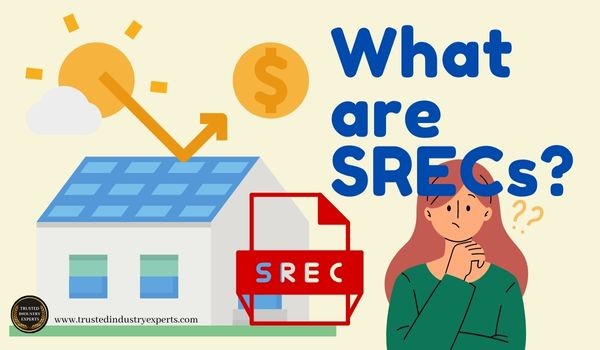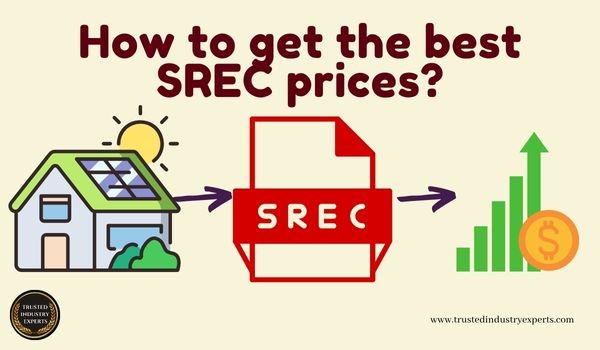What are SRECs?

SRECs are a type of tradable commodity that solar energy system owners can generate for every 1,000 kilowatt-hours (kWh) of electricity their system produces. It is a way for states to incentivize solar panel installation and use. SRECs are created and issued by state agencies to incentivize the installation and use of solar panels. They can be traded in a state’s SREC market or sold to utilities that need to meet state-mandated Renewable Portfolio Standards (RPS).
As the awareness of solar energy increases, people are encouraged to invest in solar systems. This leads to the generation of SRECs, which can be sold on the market, allowing homeowners and businesses to profit while reducing their carbon footprint. The Renewable Portfolio Standard requires utility companies to purchase a certain amount of renewable energy, which promotes the use of solar power. This provides communities with access to clean energy and the opportunity for financial gain.
Solar Renewable Energy Certificates
Solar energy systems generate electricity which can be sold to utilities, resulting in a powerful incentive for renewable energy generation. A solar panel system generates a Solar Renewable Energy Certificate (SREC) for every 1,000 kilowatt-hours (kWh) of electricity produced. These SRECs can help offset the cost of installation and provide income to the producer, while also helping with their environmental goals. The SRECs created by solar energy systems are required by utilities to meet state-mandated Renewable Portfolio Standards (RPS). The RPS requires that utility companies purchase a certain amount of electricity from renewable sources such as solar power systems. This incentive encourages more people and businesses to invest in solar systems, enabling them to become producers of renewable energy who benefit financially from their investments and help reduce their carbon footprint.
Utilities are required by their electricity supplier to meet certain Renewable Portfolio Standards (RPS) mandating the purchase of a certain amount of electricity from renewable sources such as solar power systems. By investing in solar production, utility companies can benefit financially while also reducing their carbon footprint. As solar energy gains popularity, it generates SRECs for every 1,000 kWh produced, offsetting installation costs and generating income. This encourages broader access to clean energy from utility companies and other suppliers.
How do SRECs work?
Once an SREC is created, it can be sold or traded on the open market. A solar energy system owner can sell SRECs directly to an SREC aggregator or broker, who will then sell them to utilities. The price of SRECs is determined by supply and demand in the market, and it fluctuates based on the state’s RPS targets, market forces, and the overall supply of SRECs.
As states implement Renewable Energy Generation Requirements, demand for Solar Renewable Energy Certificates rises. This motivates entities to install solar systems and generate SRECs to sell for financial gain. With increased RPS targets, utilities must purchase more renewable electricity from solar, providing another financial avenue for producers. Governments encourage sustainable energy portfolios, making now a prime time for investment in renewable energy production.
How to get the best SREC prices?

To get the best SREC prices, you need to understand the factors that influence the price. The most important factors are the supply and demand of SRECs, as well as the state’s RPS targets. The more demand there is for SRECs, the higher the price will be. Conversely, if there is an oversupply of SRECs, the price will decrease.
To maximize your SREC earnings, you need to be aware of when the market is most active. The highest demand for SRECs usually occurs in the spring and summer months when electricity consumption is at its highest. It is also essential to track the state’s RPS targets and be aware of any changes that might impact SREC prices.
Solar Renewable Energy Credits
Solar Renewable Energy Certificates (SRECs) provide an important incentive for individuals and businesses to invest in renewable energy production. When utilities fail to meet the state’s Renewable Portfolio Standard (RPS), they must pay Alternative Compliance Payments (ACPs). By using renewable resources, like solar power, financial incentives are given to producers to generate SRECs. State regulations mandate utilities purchase a certain percentage of electricity from renewable sources, creating further incentives. Both state and federal governments encourage renewable energy with ACPs and RPS targets, making solar energy a worthwhile investment with rewards for reducing carbon emissions and financial gains.
Solar Electricity, Incentives and Bills: Solar Renewable Energy Credit
Solar incentives are an important part of encouraging renewable energy production and incentivizing investments in solar panel systems. By generating SRECs for every 1,000 kWh of solar power produced, individuals and businesses become renewable energy producers who can profit from their investment while reducing their carbon footprint and saving money on monthly bills. As a result of state-mandated Renewable Portfolio Standards, utility companies are incentivized to purchase a certain percentage of their electricity from renewable resources, making solar installation an attractive option for those looking to make a positive impact on the environment.
How to sell SRECs?
There are two ways to sell SRECs: directly or through an aggregator or broker. When selling SRECs directly, you will need to find a buyer on your own. It can be a challenging and time-consuming process. Alternatively, you can sell your SRECs through an aggregator or broker who will take care of everything for you.
Aggregators and brokers will market your SRECs to buyers and handle all the paperwork involved in the transaction. They will charge a commission fee for their services, which can range from 5% to 10% of the sale price.
The SREC markets are similar to the stock market, in that solar owners and companies can trade SRECs like stocks. As states introduce “solar carve out” plans, utility companies must buy a certain amount of renewable energy. This has boosted demand for SRECs, providing an ideal opportunity for solar owners to profit from their investments. As governments increasingly support the development of sustainable energy sources, there’s never been a better time to go green and make money.
Solar Alternative compliance Payment
As solar companies and installers generate electricity measured in MWh, SRECs can be acquired for environmental, social and economic benefits. SRECs equal one MWh of electricity and are sold or traded on the open market. As more states adopt renewable portfolio standards, businesses and individuals invest in solar power to earn financial rewards and decrease their environmental impact. Essentially, the demand for SRECs grows in response to rising RPS targets.
Program and Income (SREC)
With the rise in demand for SRECs, solar installers and individuals/businesses invest in solar projects to reduce their carbon footprint and gain financial benefits through increased demand for solar energy production.
Some Utility company or companies are increasingly turning to Solar Renewable Energy Certificates (SRECs) as a way to meet Renewable Portfolio Standards (RPS). As a result, SREC income has become an attractive option for solar projects and solar installers alike. Solar production investment offers financial and environmental benefits by selling SRECs and reducing carbon footprint. As RPS targets increase, utilities must buy more solar-generated electricity, creating more financial incentives for producers. For solar installer, this means more opportunities to receive additional income from their investment in renewable energy production. Investing in solar projects through SREC programs is not only advantageous financially but also environmentally friendly – individuals and businesses are able to reduce their carbon footprint while receiving monetary rewards from their investments in clean energy.
By comprehending the market factors and following the state’s RPS goals, solar system owners can profit through SRECs. Utilizing an aggregator or broker to facilitate selling can aid in time management and yield better pricing. We hope this article has provided valuable insights into how to get the best SREC prices for your solar panels.
Solar RECs provide a great opportunity for solar companies to generate additional income from their investments in renewable energy production. Furthermore, solar companies can financially benefit and decrease carbon emissions by utilizing solar projects and generating SRECs. With rising RPS targets and solar carve-outs, renewable energy purchases from utilities present a valuable opportunity for solar producers to invest in clean energy production while boosting profits and promoting environmental sustainability.
Go Solar with Trusted Industry Experts and Contact us here
#GoSolar #RenewableEnergy #SolarPower #CleanEnergy #SRECs #RPS #AlternativeCompliancePayments #SolarCarveOuts #SolarIncentives #FinancialRewards #EnvironmentalImpact



